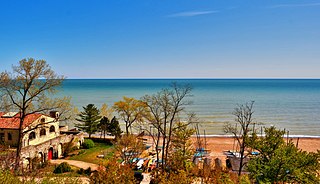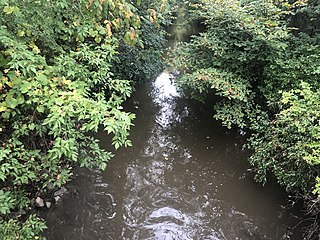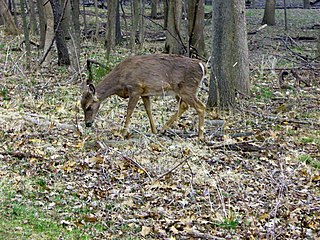
Glencoe is a lakefront village in northeastern Cook County, Illinois, United States. As of the 2020 census, the population was 8,849. Glencoe is part of Chicago's North Shore and one of the wealthiest communities in Illinois.

The Kankakee River is a tributary of the Illinois River, approximately 133 miles (214 km) long, in the Central Corn Belt Plains of northwestern Indiana and northeastern Illinois in the United States. At one time, the river drained one of the largest wetlands in North America and furnished a significant portage between the Great Lakes and the Mississippi River. Significantly altered from its original channel, it flows through a primarily rural farming region of reclaimed cropland, south of Lake Michigan.

The North Shore consists of many affluent suburbs north of Chicago, Illinois, bordering the shores of Lake Michigan. These communities fall within suburban Cook County and Lake County. The North Shore's membership is often a topic of debate, and it includes some Chicago suburbs which do not border Lake Michigan. However, Lake Bluff, Lake Forest, Highwood, Highland Park, Deerfield, Glencoe, Northbrook, Northfield, Winnetka, Kenilworth, Wilmette, Golf, Glenview, Skokie, Lincolnwood, and Evanston, are generally considered to be the main constituents of the North Shore. The North Shore is known for its affluence, high level of education, proximity to Chicago, and top-rated public schools. Lake County, Illinois is among the wealthiest counties in the U.S. and several of the wealthiest zip codes are there.

First acquired in 1977, Big Lagoon State Park is a 705-acre (2.85 km2) Florida State Park located on the northwestern Florida coast, approximately 10 miles (16 km) southwest of Pensacola on Gulf Beach Highway. It encompasses the northern boundary of Big Lagoon as it snakes toward Pensacola Bay to the east. Wild Grande Lagoon and its minor tributaries lay within the boundaries of the park, as does the alligator-inhabited Long Pond, a man-made freshwater pond.

Area codes 847 and 224 are telephone area codes in the North American Numbering Plan (NANP) for the U.S. state of Illinois. The numbering plan area (NPA) comprises the northeastern part of Illinois and many northern suburbs of Chicago. This includes most of Lake County, the northern part of Cook County, the northern part of Kane County, and a small part of McHenry County.

Wolf Lake is an 804-acre (325.4 ha) lake that straddles the Indiana and Illinois state line near Lake Michigan. It is smaller than it was prior to settlement by European colonizers because of infilling for development around the edges. Despite years of environmental damage caused by heavy industries, transportation infrastructure, urban runoff and filling of wetlands, it is one of the most important biological sites in the Chicago region.
McDowell Grove Forest Preserve, located in Naperville, state of Illinois, is a 439-acre (178 ha) preserve on the West Branch of the DuPage River.

The Forest Preserve District of Cook County is a governmental commission in Cook County, Illinois, that owns and manages land containing forest, prairie, wetland, streams, and lakes. These land holdings are primarily managed as undeveloped natural areas and for outdoor recreation. The Forest Preserve District encompasses approximately 70,000 acres of land or approximately 11% of the land in Cook County, which contains the city of Chicago and is the most densely populated urban metropolitan area in the Midwest. The Forest Preserves also owns the lands on which the Brookfield Zoo and the Chicago Botanic Garden operate, and its Chicago Portage area preserve is also affiliated with the United States National Park Service.

The Skokie River is a 20-mile-long (32 km) river that flows through the northern suburbs of Chicago, Illinois, United States. It flows almost parallel to the shore of Lake Michigan, and historically discharged its outflow into that lake via the Chicago River. However, the construction of the Chicago Sanitary and Ship Canal in 1900 caused the drainage of the Chicago River, including its Skokie River tributary, to flow southwestward towards the Mississippi River.
William W. Powers State Recreation Area is an Illinois state park administered by the Illinois Department of Natural Resources on 580 acres (230 ha) in the Hegewisch community area of the City of Chicago in Cook County, Illinois, United States. The area includes 419 acres (170 ha) of water in Wolf Lake that provides about 6 miles (10 km) of shoreline to fishermen. The park hosts about half a million visitors annually. The park contains numerous species, and is one of the most important biological sites in the Chicago region.

Silver Springs State Fish and Wildlife Area is an Illinois state park on 1,350 acres (550 ha) in Kendall County, Illinois, United States. The park was established in the late 1960s and is named for the natural spring within its boundaries. The park has two artificial lakes and the Fox River flows through the northern end of the park. Silver Springs hosts a variety of activities including fishing, hunting, boating and hiking. The park has areas of native prairie restoration, a sledding hill and a seven-mile (11 km) equestrian trail. The prairie restoration areas hold many species of plants including lead plant, and purple coneflower.

The North Branch Trail is a Class I bicycle trail located in northeastern Cook County, Illinois. The trail starts at the western part of Gompers Park in Chicago, and from there it continues north approximately 22 miles (35 km) to Glencoe. The trail follows a path along the North Branch of the Chicago River, the Skokie River and the Skokie Lagoons.

Lake Cook Road is a major east–west highway in Cook, Lake, McHenry, and Kane Counties in Illinois. For much of its length, it marks the border between Cook and Lake Counties, hence the name of the road. In its western stretch, it marks the border between McHenry and Cook Counties, and further west, McHenry and Kane Counties. The road is approximately 25.5 miles (41.0 km) in length, from its western terminus at Illinois Route 62 in Algonquin to its eastern terminus at Sheridan Road in Highland Park and Glencoe, near Lake Michigan. The road is notable for its cross-section of Chicago's northern suburbs, balancing densely developed commercial, industrial, and residential land uses, with open space areas such as forest preserves, parks, golf courses, creeks, rivers, gardens, and Lake Michigan.

The Cosumnes River Preserve is a nature preserve of over 51,000 acres (210 km2) located 20 miles (30 km) south of Sacramento, in the US state of California. The preserve protects a Central Valley remnant that once contained one of the largest expanses of oak tree savanna, riparian oak forest and wetland habitat in North America. Agricultural development has changed the landscape from groves of oaks and tule marshes to productive farmlands.

Banner Marsh State Fish and Wildlife Area is an Illinois state park covering 4,363 acres (1,766 ha) in Fulton County, Illinois, United States.

The Palos Forest Preserves are 15,000 acres of forest preserves in the Forest Preserve District of Cook County, located principally in Palos Township, Illinois.

Powerton Lake State Fish and Wildlife Area is a 1,426-acre (577 ha) area of semi-protected habitat on the Illinois River southwest of to the city of Pekin, Illinois within Tazewell County in the U.S. state of Illinois. The parcel is a cooling reservoir owned by NRG Energy, an electric power generating firm, and is operated by the Illinois Department of Natural Resources (IDNR). The lake is used for fishing, with an emphasis on blue catfish. In addition, IDNR states that approximately 60% of the cooling pond is used for duck and goose hunting during legal hunting seasons. The remaining 40% of the pond is maintained as a waterfowl refuge on a year-round basis.

The Étang d'Urbino is a coastal lagoon beside the Tyrrhenian Sea in the Haute-Corse department on the French island of Corsica.
Friends of the Chicago River is a non-profit organization that was founded in 1979 to improve and restore the 156-mile Chicago River and Calumet River system for all people, water, and animals. Friends of the Chicago River works through education and outreach, on the ground projects, and public policy and planning to achieve their vision that the Chicago-Calumet River system and its watershed are a healthy, climate resilient, biologically rich ecosystem with equitable, open access for all.

Camp Skokie Valley was a United States Army installation built in Glenview, Illinois, north of Chicago. Its archaeological remnants are found in Blue Star Memorial Woods, a property owned and managed by the Cook County Forest Preserve District.





















